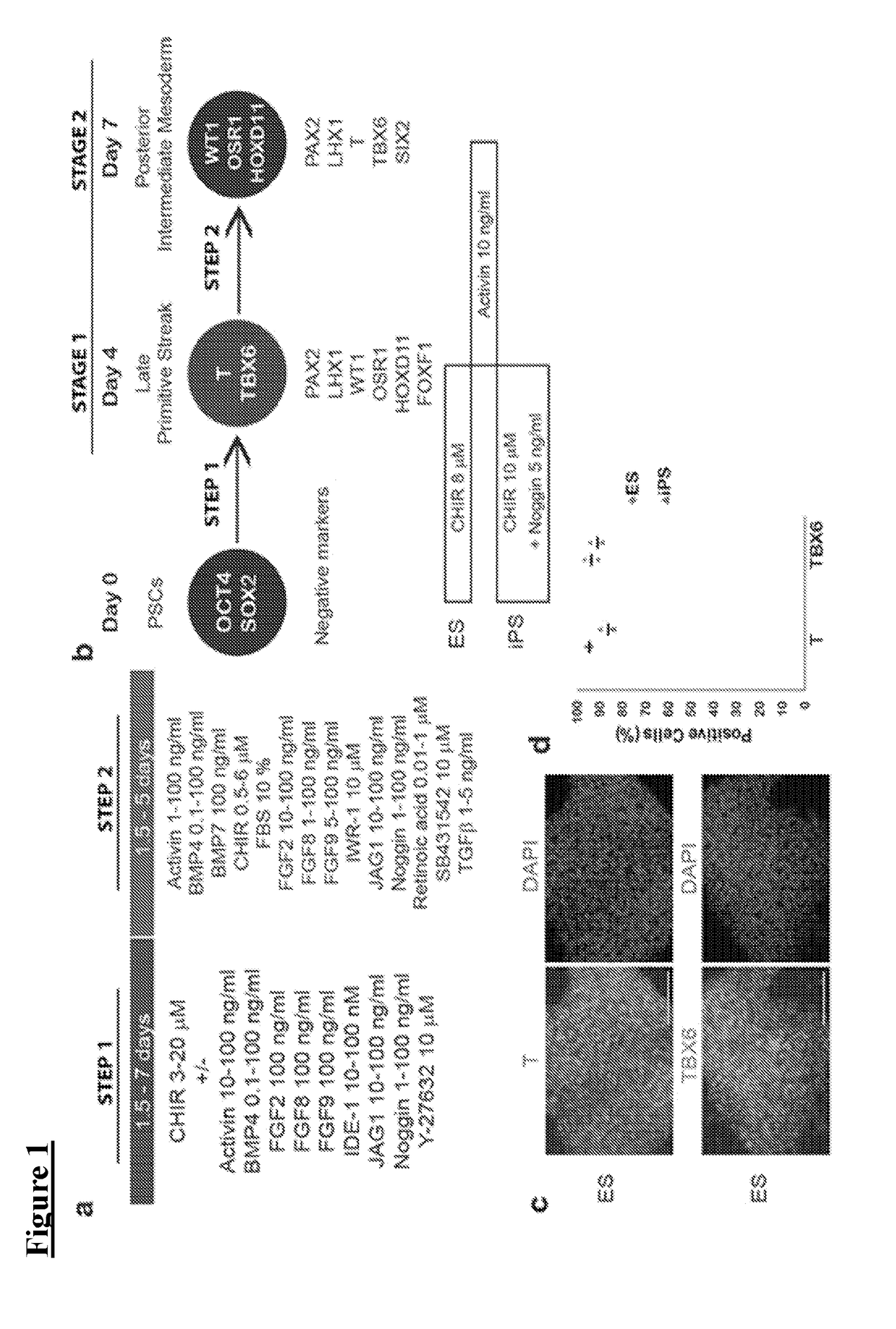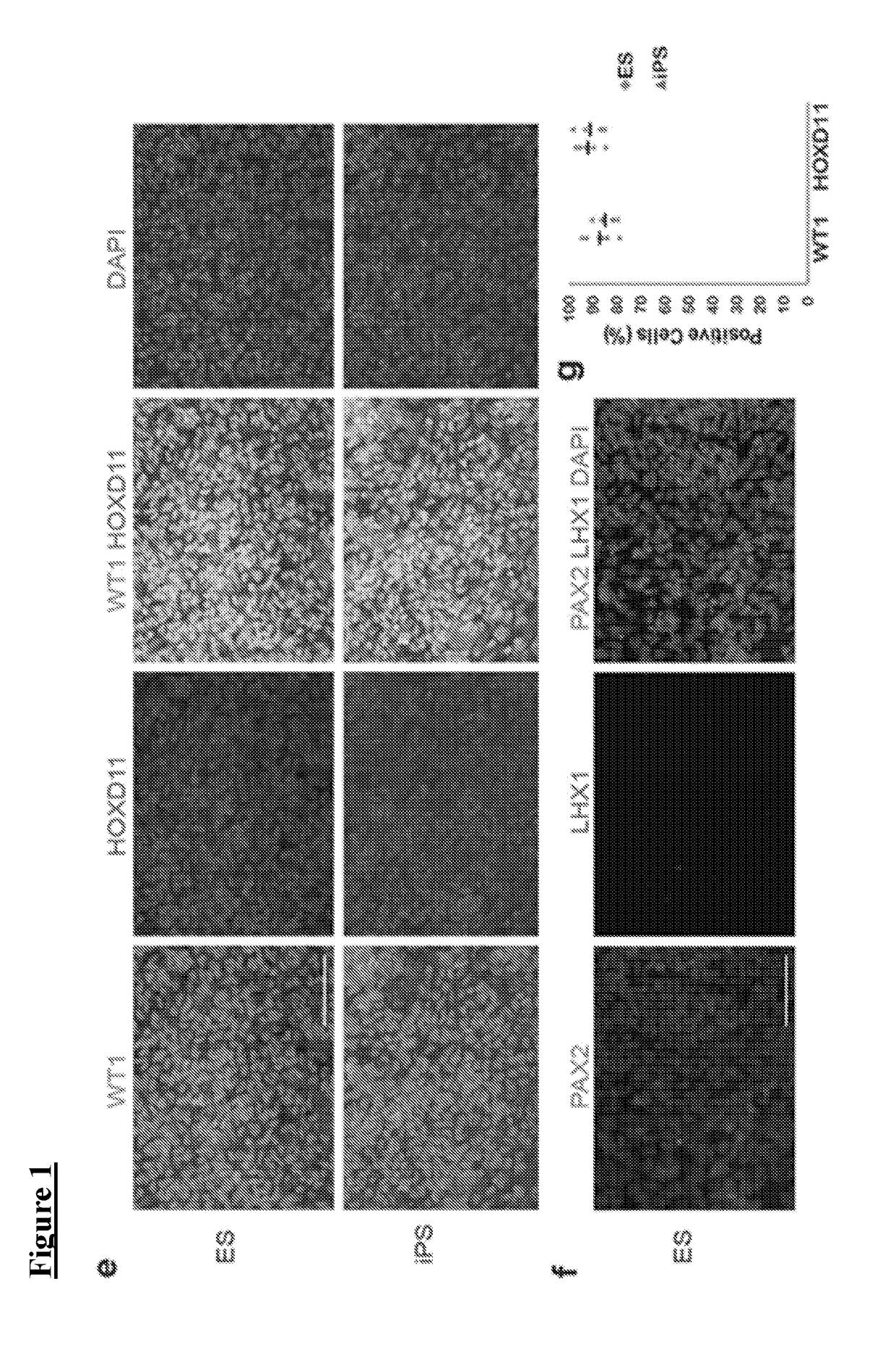Methods of generating nephrons from human pluripotent stem cells
a technology of human pluripotent stem cells and nephrons, which is applied in the field of nephron progenitor cells and kidney organoids, can solve the problems of low differentiation efficiency of nephrons for large-scale production of npcs, complicated efforts of nephrons to generate them in vitro, and serious public health problems
- Summary
- Abstract
- Description
- Claims
- Application Information
AI Technical Summary
Benefits of technology
Problems solved by technology
Method used
Image
Examples
example 1
Maintenance of hPSCs
[0071]H9 human ESCs (passage 45-65), and HDF-α human iPSCs (hiPSC derived from healthy fibroblasts; passage 22-42) were maintained in ReproFF2 (ReproCELL, #RCHEMD006) supplemented with FGF2 (10 ng / mL) (Peprotech, #100-18B) in 6-well tissue culture plates (Falcon, #353046) coated with 1% vol / vol LDEV-Free hESC-qualified Geltrex (Life Technologies, #A1413302) in a 37° C. incubator with 5% CO2. hPSCs were passaged using Dissociation Solution for human ES / iPS cells (ReproCELL, #RCHETP002) at a 1:3 split ratio every 7 days according to the manufacturer's protocol. H9 was purchased from WiCell. HDF-α human iPSCs was previously established in the Inventors' laboratory.
example 2
Differentiation of hPSCs
[0072]hPSCs grown on Geltrex were washed once with PBS (Life Technologies, #10010-049) and dissociated into single cells with Accutase (STEMCELL Technologies, #07920). Cells were then plated at a density of 2-2.4×104 (H9) or 1-1.4×104 (HDF, 2C) cells / cm2 onto 24-well tissue culture plates (TPP, #92024) coated with 1% Geltrex in ReproFF2 supplemented with the ROCK inhibitor Y27632 (10 μM) (TOCRIS, #1254) and FGF2 (10 ng / ml). After 72 hours, cells (50% confluent) were briefly washed in PBS and then cultured in basic differentiation medium consisting of Advanced RPMI 1640 (Life Technologies, #12633-020) and 1X L-GlutaMAX (Life Technologies, #35050-061) supplemented with CHIR99021 (8-10 μM) (TOCRIS, #4423) for 4 days to induce late primitive streak cells Noggin (5 ng / ml) was also used for hiPSC differentiation in addition to CHIR (10 μM). To induce posterior intermediate mesoderm, cells were then cultured in Advanced RPMI+1X L-GlutaMAX+activin (10 ng / mL) (R&D, #3...
example 4
[0074]3D kidney organoids were cultured in basic differentiation medium supplemented with gentamicin 5×10−4, 5×10−2, or 5 mg / mL (Sigma, #G1264) for 48 hours or cisplatin 5 or 50 μM (Sigma, #P4394) for 2, 6, 24 or 48 hours after day 21 of differentiation. Organoids were then fixed with 4% paraformaldehyde (Electron Microscopy Sciences, #RT15710) for 20 minutes for both whole-mount and frozen section immunohistochemistry.
PUM
| Property | Measurement | Unit |
|---|---|---|
| concentration | aaaaa | aaaaa |
| concentration | aaaaa | aaaaa |
| concentration | aaaaa | aaaaa |
Abstract
Description
Claims
Application Information
 Login to View More
Login to View More - R&D
- Intellectual Property
- Life Sciences
- Materials
- Tech Scout
- Unparalleled Data Quality
- Higher Quality Content
- 60% Fewer Hallucinations
Browse by: Latest US Patents, China's latest patents, Technical Efficacy Thesaurus, Application Domain, Technology Topic, Popular Technical Reports.
© 2025 PatSnap. All rights reserved.Legal|Privacy policy|Modern Slavery Act Transparency Statement|Sitemap|About US| Contact US: help@patsnap.com



